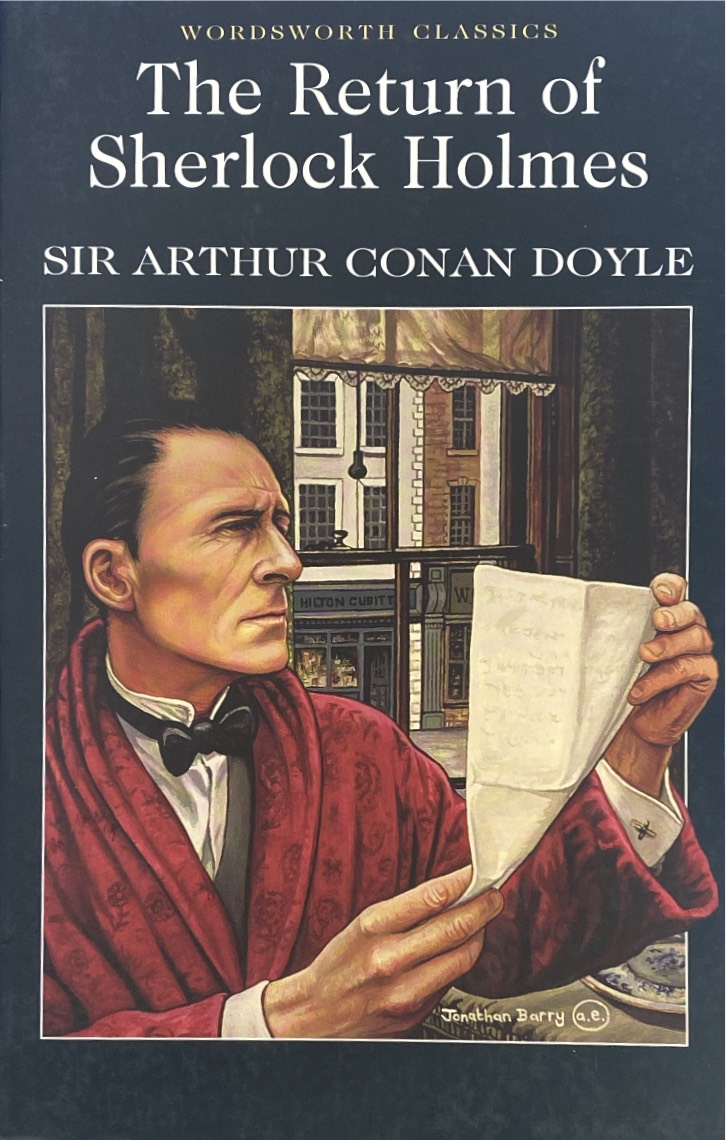The Return of Sherlock Holmes
Mô tả ngắn
The Return of Sherlock Holmes (Wordsworth Classics) by Sir Arthur Conan Doyle is the final short-story collection penned by the inventor of the fictional sleuth. It includes the last 13 canonical limi...- Giao hàng toàn quốc
- Được kiểm tra hàng
- Thanh toán khi nhận hàng
- Chất lượng, Uy tín
- 7 ngày đổi trả dễ dàng
- Hỗ trợ xuất hóa đơn đỏ
Giới thiệu The Return of Sherlock Holmes
The Return of Sherlock Holmes (Wordsworth Classics) by Sir Arthur Conan Doyle is the final short-story collection penned by the inventor of the fictional sleuth. It includes the last 13 canonical limited-words tales featuring the adventures of Holmes and his colleague, Dr. John Watson.
It was a treat to finally have finished this last compilation of Sherlockian short-fiction. Years ago I had completed all the canonical literary material featuring Holmes save for this one. Having forgotten about this book I only noticed it last week when I was inspecting my oldest bookshelf.
I started reading the original SH stories after watching the first season of the BBC program, Sherlock, in 2010. I had doubts about going through the books because their contents took place in the last 1800s and the early 1900s, while the show was based in the 21st century.
However, I was amazed at the quality, and even more so, by the pace of Doyle’s writing. Unlike other 20th-century mystery scribes, such as Agatha Christie and Ruth Rendell, Doyle’s penmanship showcased how the power of reasoning could overshadow any seemingly unsolvable crime. Doyle’s Sherlock Holmes was also a far more intellectual detective than both Christie’s equally Hercule Poirot and Rendell’s Inspector Wexford.
Without further ado, I present to you each story below, in order of their appearance in the table of contents, reviewed separately. The individual ratings, as well as the aggregate score, can be seen in the Review Overview section following the end of this article. SPOILERS ahead.
- The Empty House: A direct sequel to Doyle’s short story, The Final Problem, which showcased the apparent death of the expert sleuth. The Empty House pays tribute to the title of the collection, The Return of Sherlock Holmes, not only because it depicts his return to London, but also that Holmes’ explanation of being alive is finally illustrated literature-wise. An overall enticing tale but the subplot of Holmes’ comeback frequently distracts from the main plot of an otherwise engaging case.
- The Norwood Builder: Points for uniqueness because the suspect is outlined as visiting the Baker Street house instead of the victim. The unveiling of the actual perpetrator was handled with finesse, but the comprehensive case-solving could have done with a tad less predictability.
- The Dancing Men: One of the most memorable stories in this compilation. Holmes not only gets to reveal his knowledge of semiotics, by telling others that he has analyzed one hundred and sixty separate ciphers, but he also puts it to productive usage in of the most bizarre cases that’ll be narrated to first-time readers. Finding out about the death of the person who requested Holmes’ aid, Hilton Cubitt, was a depressing scenario, but the well-penned epilogue depicted how his wife helped carry on her unfortunate ex-husband’s legacy.
- The Solitary Cyclist: A clichéd yarn featuring an almost comical case. What’s worse is that it seems Doyle combined the subplots of 2-3 previous entries in his past collections and then made a mess of the end result.
- The Priory School: The solving of the case by Holmes was as usual, amusing, but near the point of the dilemma’s solution, the plot became unnaturally anti-climactic.
- Black Peter: The unique factor was the introduction of Stanley Hopkins, an inspector, unlike Lestrade, who fully acknowledges Holmes’ traits of deduction. However, it’s a semi-predictable case which will be swiftly deciphered, early into the story, by the most veteran of mystery enthusiasts.
- Charles Augustus Milverton: The titular character is the most loathsome villain that Holmes has encountered since Moriarty’s debut. Moriarty’s personality was expertly utilized by Doyle as a plot device, and the author’s descriptive writing is at the height of his literary abilities here—as we also get to read about Holmes and Watson carrying out a mission of crime for the greater good. The only drawback in this one-of-a-kind yarn is that there’s almost no trace of a mystery till the last few pages.
- The Six Napoleons: Such an ingeniously contrived mystery that, even if you have guessed the reasoning behind the crime halfway into the story, you’ll still be shocked by how superhumanly Holmes connected the dots which were initially scattered everywhere. Overall, one of Doyle’s finest short-stories featuring the unparalleled acumen of the world’s most famous fictional detective.
- The Three Students: A seemingly unsolvable puzzle. It’s a case even the most experienced Sherlockians will find difficult to crack.
- The Golden Pince-Nez: This one has undoubtedly taken a top 10 spot in my list of favorite SH short-stories. I am safe to state that the majority of this compilation’s readers will share my viewpoint. It was also delightful to come across again the indirect scolding of Stanley Hopkins, by his mentor, Sherlock Holmes.
- The Missing Three-Quarter: I found that Holmes’ thoughts on amateur sports were more entertaining than this involuntarily prolonged account.
- Abbey Grange: The first half overshadowed the second and my notion is that this aspect always undermines the effect of an entry in the mystery genre. Still, this story is a rarity as it concludes with Holmes passing down judgment on the accused on the basis of love rather than true justice.
- The Second Stain: I can’t term this story as the last but not the least of the collection. Yes, the thriller encompassed international politics, but the man tasked with unraveling it might as well have been James Bond. The tension was successfully built up at the onset of the tale with the stakes risen to an almost impossible level. But Doyle could have certainly done with a superior farewell for his signature character in this concise form of prose fiction.
That’s it for the lineup of the 13 stories incorporated in The Return of Sherlock Holmes. What makes this Wordsworth Classics edition even better is the foreword written by John S. Whitley, Emeritus Reader of American Studies, at the University of Sussex. In the introductory section of this book, he has analyzed the everlasting value of Sherlockian literature, as well as the mystery genre as a whole, with an incomparable flair.
Giá sản phẩm trên Tiki đã bao gồm thuế theo luật hiện hành. Bên cạnh đó, tuỳ vào loại sản phẩm, hình thức và địa chỉ giao hàng mà có thể phát sinh thêm chi phí khác như phí vận chuyển, phụ phí hàng cồng kềnh, thuế nhập khẩu (đối với đơn hàng giao từ nước ngoài có giá trị trên 1 triệu đồng).....
Giá MKT
Thông tin chi tiết
| Công ty phát hành | Công ty cổ phần Đầu tư và Phát triển Giáo dục Hà Nội |
|---|---|
| Nhà xuất bản | Nhà Xuất Bản Giáo Dục Việt Nam |
| ISBN-13 | 978-1-85326-058-2 |
| Loại bìa | Bìa mềm |
| SKU | 5693425250151 |
Từ khóa
grimm fairy tales david walliams hamlet english books alice in wonderland shakespeare les misérables little prince le petit prince robinson crusoe the little prince pride and prejudice phantom of the opera a tale of two cities wuthering heights game of thrones the lord of the rings the witcher narnia the hobbit the book thief the alchemist book thief kẻ trộm sách the great gatsby odyssey sherlock holmes english the house on mango street wordworth classics the seven husbands of evelyn hugo






